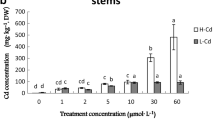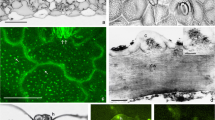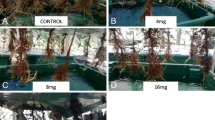Abstract.
Brassica napus (L.) was grown from seeds on a reconstituted soil contaminated with 100 mg Cd kg-1. Compared with roots and stems, leaves accumulated high amounts of Cd. Although the Cd concentration in the leaves remained high throughout plant growth and no appreciable change was noticed in the total, extractable or soluble Cd in the soil adhering to the roots, the symptoms of Cd toxicity (leaf chlorosis, growth retardation) decreased with time. Cd induced a noticeable accumulation of phytochelatins in young plants (aged 22 days), which decreased in parallel to the disappearance of the symptoms of Cd intoxication. The subcellular distribution of Cd in leaves of Cd-acclimated plants was determined using biochemical, microscopic and metal-imaging techniques. Leaf fractionation by differential centrifugations showed that Cd was present predominantly in the 'soluble' fraction corresponding to the vacuoles and the cytoplasm. Transmission electron microscopic analyses revealed that those cell compartments contained electron-dense granules associated with needle-like structures. Cd, and also high amounts of sulfur, was detected in those structures by electron-spectroscopic imaging. This technique also showed Cd binding to cell walls by a mechanism that does not involve sulfur atoms. In contrast, very little Cd was found in chloroplasts, and this is consistent with the preservation of photosynthesis in plants grown on Cd-polluted soil. The microanalytical results presented here confirm that long-term growth of B. napus on Cd-contaminated soil is accompanied by preferential storage of Cd in the vacuoles and the cell walls. This phenomenon diverted Cd ions from metabolically active compartments (cytosol, chloroplasts, mitochondria), resulting in a reduction of Cd toxicity in the leaves.
Similar content being viewed by others
Author information
Authors and Affiliations
Additional information
Electronic Publication
Rights and permissions
About this article
Cite this article
Carrier, P., Baryla, A. & Havaux, M. Cadmium distribution and microlocalization in oilseed rape (Brassica napus) after long-term growth on cadmium-contaminated soil. Planta 216, 939–950 (2003). https://doi.org/10.1007/s00425-002-0947-6
Received:
Accepted:
Issue Date:
DOI: https://doi.org/10.1007/s00425-002-0947-6




